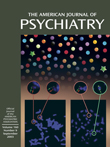Lateralization of Auditory Sensory Gating and Neuropsychological Dysfunction in Schizophrenia
Abstract
OBJECTIVE: Sensory gating assessed via EEG in a paired-click paradigm has often served as a neurophysiological metric of attentional function in schizophrenia. However, the standard EEG measure of sensory gating using the P50 component at electrode Cz does not foster differential assessment of left and right hemisphere contributions. Magnetoencephalography (MEG) is complementary to EEG, and its analogous M50 component may be better suited for localization and analysis of such lateralized cortical generators. The authors hypothesized that 1) auditory gating would be evident in M50 sources in superior temporal gyrus, demonstrating ratios similar to P50; 2) M50 would resemble P50 in distinguishing gating in comparison subjects and patients with schizophrenia, but M50 would show lateralization of the gating deficit; and 3) P50 and M50 sensory gating ratios would predict neuropsychological measures in patients and comparison subjects, with the MEG identification of left and right hemisphere sources allowing for the evaluation of lateralization in brain-behavior relationships. METHOD: Event-related EEG and MEG recordings were simultaneously obtained from 20 patients with schizophrenia and 15 comparison subjects. P50 amplitudes, M50 dipole source strengths, and P50 and M50 gating ratios were compared and assessed with respect to scores on neuropsychological performance measures. RESULTS: M50 dipoles localizing to superior temporal gyrus demonstrated gating similar to that of P50. As expected, patients demonstrated less P50 gating than did comparison subjects. Left (but not right) hemisphere M50 gating 1) correlated with EEG gating, 2) differentiated patients and comparison subjects, and 3) correlated with neuropsychological measures of sustained attention and working memory. CONCLUSIONS: Converging evidence from EEG, MEG, and neuropsychological measures points to left hemisphere dysfunction as strongly related to the well-established sensory gating deficit in schizophrenia.



